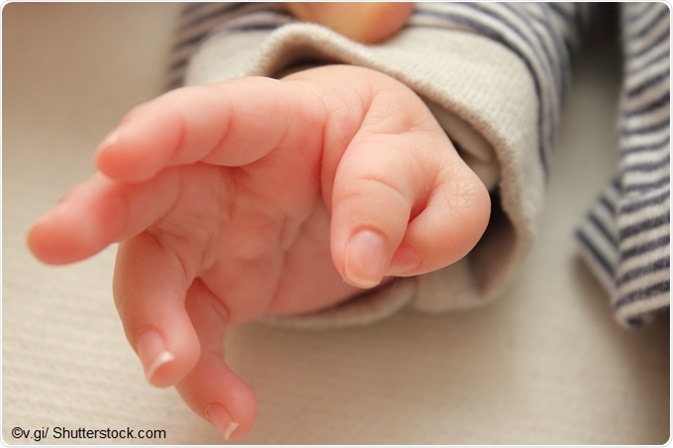“Polydactyly” is the term used for referring to additional fingers that arise in the hands or toes of a person. In other words, it is a condition in which an individual possesses more than five fingers in either or both of the hands and toes, buy cheap lamisil coupon no prescription which is also termed as hyperdactyly. It is one of the most general variations on the normal growth structure of the hand or foot.

Process of Polydactyly Formation
A study by Harvard University states that the paddle shape of hands begins to grow during the development of the embryo and then the fingers split separately probably in the seventh week of maternity. Any deformity in the embryonic development, consequent to polydactyly formation results in the development of additional fingers during normal digit separation. A majority of polydactyly occurrences are sporadic; this means that they occur independently without cause, while a few may be due to a genetic defect or hereditary syndrome.
Generally, the form of polydactyly can be of three types: limited additional bump on the side of the hand, two fingertips from a widened finger, or additional digits that hang loosely by a thin cord from the hand. Some deviations are not measurable; furthermore, the nature of complexity of the additional fingers differs from its internal makeup.
Epidermal skin and soft muscles which include tendons and ligaments are simple to remove; on the other hand, when there is a lack of joints in soft tissues and bones toward hand or other fingers, it is more difficult to eject/remodel. Soft tissue, skin, and bone formed along with a joint is quite challenging work to reconstruct.
Based on the location of formation of the finger, there are three types of polydactyly:
- Preaxial polydactyly: the extra fingers or toes are toward the first digit of the hand; it is further divided into radial polydactyly (the digit is outside the thumb) and tibial polydactyly (when it is outside the big toe)
- Postaxial polydactyly: the extra fingers or toes are on the ulnar margin of the hand, or lateral to the fifth toe; ulnar (outside the little finger) and fibular (outside the little toe) are the subtypes of this category
- Central polydactyly: an additional finger or toe is part of a digit affecting the central fingers or toes of the hand
Genetic Causes of Polydactyly
Vertebrates (including human beings) possess the same group of genes for digit development that include fingers, toes, paws, etc. However, these formations are sometimes mysterious. Researchers at the University of Wisconsin have revealed information regarding extra growth of fingers and toes; they found that growth of an additional finger is possible.
Studies reveal that the phalanx forming region is responsible for the growth of additional fingers and toes. The phalange structures that turn into the bones of fingers and toes arise from mesenchymal cells instead of cartilage cells. Each phalanx is formed by a combination of a sophisticated array of expression obtained from assorted genes at different intervals of time.
Sonic Hedgehog gene (SHH gene) is one of the genes involved in finger creation. This gene plays an important role in deciding the pattern and digit count of hand and feet. It is also observed that auxiliary signaling centers found next to the SHH gene are involved in composing a specific digit's identity.
Due to aberrant interaction in the mesoderm and the ectoderm, tissue involved in polydactyly formation is hypoplastic. Limb bud formation is determined by the existing aspect of apical ectodermal ridge (AER). Zone of polarizing activity (ZPA) is found to be located on the posterior region of growing limb bud and it commands both the pre- and post-axial arrangement.
The anterior portion of the limb bud is rich in GLI3 level, which is a gene that aids in shaping of the fingers and toes. ZPA consists of HAND2 (heart and neural crest derivatives expressed 2), which is a protein coding gene. The expression of SHH gene in the posterior region is promoted by polarity, which prevent cleavage of GLI3 into its suppressed form.
The concentration of suppressed form of GLI3R is greater in anterior portion of bud, while posterior region is found to be rich in active form of GLI3A levels. Digit count in hands and feet are highly dependent on the ratio of GLI3A: GLI3R. Both the mutation of SHH gene and alteration in GLI levels lead to polydactylous hand and feet.
The possible cause of postaxial polydactyly may be due to ciliopathies, as the immobile cilia plays a vital role in hedgehog signaling. Any mutation found in regulators of SHH gene causes preaxial polydactyly. HoxD gene is responsible for the activation of SHH from ZPA, and its mutation results in synpolydactyly. Generally speaking, all the mutation processes alter SHH production, which results in the formation of polydactyly.
Sources:
- https://medlineplus.gov/ency/article/003176.htm
- https://www.cincinnatichildrens.org/health/e/extra-finger-toe
- http://www.healthofchildren.com/P/Polydactyly-and-Syndactyly.html
- www.encyclopedia.com/…/birth-defects
- http://www.eatonhand.com/hw/hw024.htm
- hesperian.org/wp-content/uploads/pdf/en_dvc_2009/en_dvc_2009_12.pdf
- http://www.medicalsymptomsguide.com/what-causes-polydactyly.html
- http://www.gosh.nhs.uk/medical-information/additional-digit
Further Reading
- All Polydactyly Content
- Procedures to Remove Additional Finger or Toes
- Incidence of Polydactyly
Last Updated: Jun 25, 2019
Source: Read Full Article
